|
The above diagram illustrates the method used by the Cassini Radio and Plasma Wave
Science (RPWS) instrument to study the rotation rate of Saturn.
Since giant gas planets such as Saturn have no surface and are shrouded
by clouds it is not possible to obtain an accurate rotation rate from
visual observations. The rotation rate most commonly quoted is obtained
by analyzing the periodic rotational modulation of radio emissions. These
radio emissions are generated by charged particles whose motions are
controlled by the planetary magnetic field. Since the magnetic field is
linked to the deep interior of the planet this technique is believed to
give the best indication of the average rotation rate of the planet. At
Saturn the radio emission that is used to determine the radio rotation
rate occurs in the frequency range from about 50 to 500 kHz and is
called Saturn Kilometric Radiation (SKR). The color frequency-time
spectrogram in the diagram shows the SKR intensity detected over a five
day interval, from June 2 to June 7, 2004. The audio sounds of these
radio emissions have been generated by shifting the radio frequency range
from 100 to 300 kHz down to the frequency range from 0 to 3 kHz and
speeding up the recording so that 1 second corresponds to one rotation.
The average rotation period obtained over an approximate one year
interval, from April 29, 2003, to June 10, 2004, during the Cassini
approach to Saturn, is 10 hr 45 min 45 ± 36 sec. This period differs
significantly from the rotation period obtained during the 1980-81
Voyager flybys of Saturn which was 10 hr 39 min 24 ± 7 sec [see Desch and
Kaiser, Geophys. Res. Lett., 8, 253-256, 1981]. The
Cassini observations confirm a result first reported by Lecacheux
[Radio Emissions IV, ed. by H. O. Rucker, S. J. Bauer, and A.
Lecacheux, Austrian Academy of Sciences Press, Vienna, pp. 313-325, 1977;
also see Galopeau and Lecacheux, Geophys. Res. Lett., 105,
13,089-13,101, 2000] using the Ulysses spacecraft that Saturn's radio
period often deviates substantially from the Voyager value. A comparison
of the power spectrums for the Voyager and Cassini measurements is shown
in the Figure below. The reason for the long term variations in Saturn's
radio rotation period is poorly understood and will require further
study.
Don Gurnett
RPWS Principal Investigator
|

